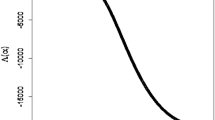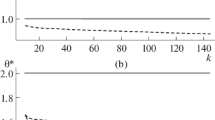Abstract
For the estimation of the tail index of a heavy tailed distribution, one of the well-known estimators is the Hill estimator (Hill, 1975). One obvious way to construct a confidence interval for the tail index is via the normal approximation of the Hill estimator. In this paper we apply both the empirical likelihood method and the parametric likelihood method to obtaining confidence intervals for the tail index. Our limited simulation study indicates that the normal approximation method is worse than the other two methods in terms of coverage probability, and the empirical likelihood method and the parametric likelihood method are comparable.
Similar content being viewed by others
References
Beirlant, J., Dierckx, G., Goegebeur, Y., and Matthys, G., “Tail index estimation and an exponential regression model,” Extremes 2(2), 177–200, (1999).
Beirlant, J., Teugels, J.L., and Vynckier, P., “Tail index estimation, Pareto quantile plots, and regression diagnostics,” J. Amer. Statist. Assoc. 91, 1695–1667, (1996).
Cheng, S. and Peng, L., “Confidence intervals for the tail index,” Bernoulli 7(5), 751–760, (2001).
Csörgő, S., Deheuvels, P., and Mason, D., “Kernel estimates of the tail index of a distribution,” Ann. Statist. 13, 1050–1077, (1985).
Csörgő, S. and Viharos, L., “Asymptotic normality of least-squares estimators of tail indices,” Bernoulli 3(3), 351–370, (1997).
Danielsson, J., de Haan, L., Peng, L., and de Vries, C., “Using a bootstrap method to choose the sample fraction in tail index estimation,” Journal of Multivariate Analysis 76, 226–248, (2001).
Danielsson, J., Hartmann, P., and de Vries, C., The cost of conservatism. RISK 11(1), 101–103, (1998).
Danielsson, J. and de Vries, C., “Tail index and quantile estimation with very high frequency data,” Journal of Empirical Finance 4, 241–257, (1997).
Dekkers, A.L.M., Einmahl, J.H.J., and de Haan, L., “A moment estimator for the index of an extreme-value distribution,” Ann. Statist. 17, 1833–1855, (1989).
DiCiccio, T.J., Hall, P., and Romano, J.P., “Empirical likelihood is Bartlett correctable,” Ann. Statist. 19, 1053–1061, (1991).
Drees, H., “Refined Pickands estimators of the extreme value index,” Ann. Statist. 23, 2059–2080, (1995).
Embrechts, P., Resnick, S., and Samorodnitsky, G., “Living on the Edge,” RISK 11(1), 96–100, (1998).
Embrechts, P., Resnick, S., and Samorodnitsky, G., “Extreme value theory as a risk management tool,” North American Actuarial Journal 3, 30–41, (1999).
Feuerverger, A. and Hall, P., “Estimating a tail exponent by modeling departure from a Pareto distribution,” Ann. Statist. 27, 760–781, (1999).
Guillou, A. and Hall, P., “A diagnostic for selecting the threshold in extreme-value analysis,” J. Roy. Statist. Soc. Ser. B. 63(2), 293–305, (2001).
De Haan, L. and Peng, L., “Comparison of tail index estimators,” Statistica Neerlandica 52(1), 60–70, (1998).
Hall, P., “On some simple estimators of an exponent of regular variation,” J. Roy. Statist. Soc. Ser. B 44, 37–42, (1982).
Hall, P. and La Scala, B., “Methodology and algorithms of empirical likelihood,” Internal. Statist. Rev. 58, 109–127, (1990).
Hall, P. and Weissman, I., “On the estimation of extreme tail probabilities,” Ann. Statist. 25(3), 1311–1326, (1997).
Hill, B.M., “A simple general approach to inference about the tail of a distribution,” Ann. Statist. 3, 1163–1174, (1975).
Mason, D., “Laws of large numbers for sums extreme values,” Ann. Probab. 10, 754–764, (1982).
McNeil, A.J., “Estimating the tails of loss severity distributions using extreme value theory,” ASTIN Bulletin 27, 117–137, (1997).
Owen, A.B., “Empirical likelihood ratio confidence intervals for a single functional,” Biometrika 75(2), 237–249, (1988).
Owen, A.B., “Empirical likelihood ratio confidence regions,” Ann. Statist. 18, 90–120, (1990).
Resnick, S.I., Discussion of the Danish data on large fire insurance losses. Preprint (1996).
Pickands III, J., “Statistical inference using extreme order statistics,” Ann. Statist. 3, 119–131, (1975).
Weissman, I., “Estimation of parameters and large quantiles based on the k largest observations,” J. Amer. Statist. Assoc. 73, 812–815, (1978).
Author information
Authors and Affiliations
Rights and permissions
About this article
Cite this article
Lu, JC., Peng, L. Likelihood Based Confidence Intervals for the Tail Index. Extremes 5, 337–352 (2002). https://doi.org/10.1023/A:1025163807024
Issue Date:
DOI: https://doi.org/10.1023/A:1025163807024




